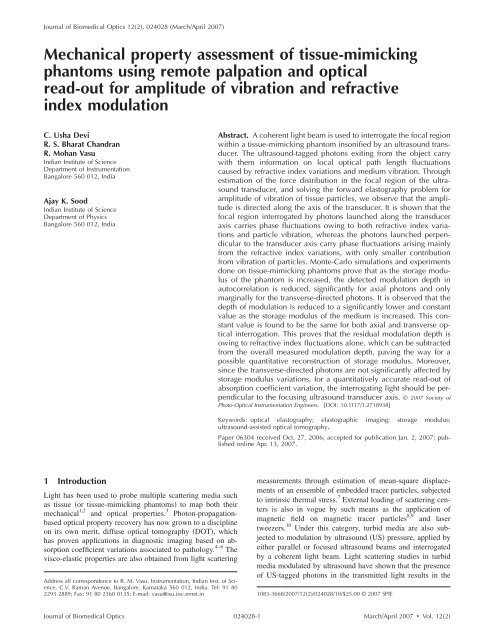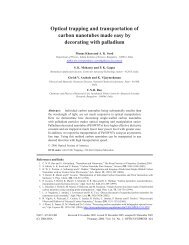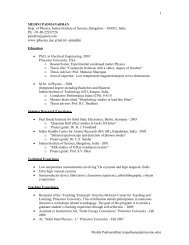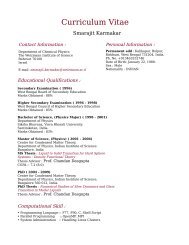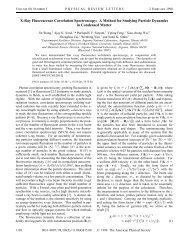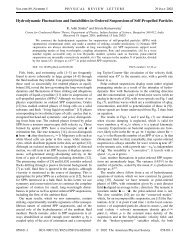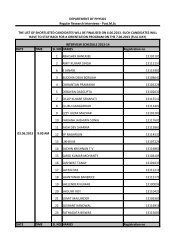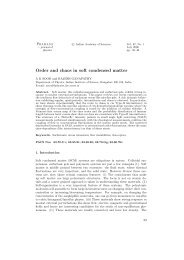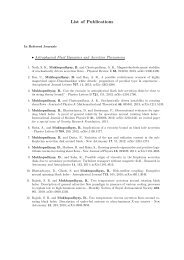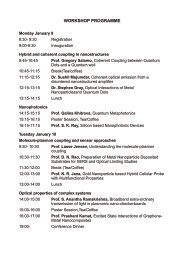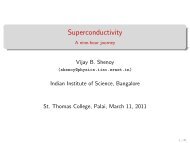C. Usha Devi, R. S. Bharat Chandran, R. M. Vasu and A.K. ... - Physics
C. Usha Devi, R. S. Bharat Chandran, R. M. Vasu and A.K. ... - Physics
C. Usha Devi, R. S. Bharat Chandran, R. M. Vasu and A.K. ... - Physics
Create successful ePaper yourself
Turn your PDF publications into a flip-book with our unique Google optimized e-Paper software.
Journal of Biomedical Optics 122, 024028 March/April 2007<br />
Mechanical property assessment of tissue-mimicking<br />
phantoms using remote palpation <strong>and</strong> optical<br />
read-out for amplitude of vibration <strong>and</strong> refractive<br />
index modulation<br />
C. <strong>Usha</strong> <strong>Devi</strong><br />
R. S. <strong>Bharat</strong> <strong>Ch<strong>and</strong>ran</strong><br />
R. Mohan <strong>Vasu</strong><br />
Indian Institute of Science<br />
Department of Instrumentation<br />
Bangalore 560 012, India<br />
Ajay K. Sood<br />
Indian Institute of Science<br />
Department of <strong>Physics</strong><br />
Bangalore 560 012, India<br />
Abstract. A coherent light beam is used to interrogate the focal region<br />
within a tissue-mimicking phantom insonified by an ultrasound transducer.<br />
The ultrasound-tagged photons exiting from the object carry<br />
with them information on local optical path length fluctuations<br />
caused by refractive index variations <strong>and</strong> medium vibration. Through<br />
estimation of the force distribution in the focal region of the ultrasound<br />
transducer, <strong>and</strong> solving the forward elastography problem for<br />
amplitude of vibration of tissue particles, we observe that the amplitude<br />
is directed along the axis of the transducer. It is shown that the<br />
focal region interrogated by photons launched along the transducer<br />
axis carries phase fluctuations owing to both refractive index variations<br />
<strong>and</strong> particle vibration, whereas the photons launched perpendicular<br />
to the transducer axis carry phase fluctuations arising mainly<br />
from the refractive index variations, with only smaller contribution<br />
from vibration of particles. Monte-Carlo simulations <strong>and</strong> experiments<br />
done on tissue-mimicking phantoms prove that as the storage modulus<br />
of the phantom is increased, the detected modulation depth in<br />
autocorrelation is reduced, significantly for axial photons <strong>and</strong> only<br />
marginally for the transverse-directed photons. It is observed that the<br />
depth of modulation is reduced to a significantly lower <strong>and</strong> constant<br />
value as the storage modulus of the medium is increased. This constant<br />
value is found to be the same for both axial <strong>and</strong> transverse optical<br />
interrogation. This proves that the residual modulation depth is<br />
owing to refractive index fluctuations alone, which can be subtracted<br />
from the overall measured modulation depth, paving the way for a<br />
possible quantitative reconstruction of storage modulus. Moreover,<br />
since the transverse-directed photons are not significantly affected by<br />
storage modulus variations, for a quantitatively accurate read-out of<br />
absorption coefficient variation, the interrogating light should be perpendicular<br />
to the focusing ultrasound transducer axis. © 2007 Society of<br />
Photo-Optical Instrumentation Engineers. DOI: 10.1117/1.2718938<br />
Keywords: optical elastography; elastographic imaging; storage modulus;<br />
ultrasound-assisted optical tomography.<br />
Paper 06304 received Oct. 27, 2006; accepted for publication Jan. 2, 2007; published<br />
online Apr. 13, 2007.<br />
1 Introduction<br />
Light has been used to probe multiple scattering media such<br />
as tissue or tissue-mimicking phantoms to map both their<br />
mechanical 1,2 <strong>and</strong> optical properties. 3 Photon-propagationbased<br />
optical property recovery has now grown to a discipline<br />
on its own merit, diffuse optical tomography DOT, which<br />
has proven applications in diagnostic imaging based on absorption<br />
coefficient variations associated to pathology. 4–6 The<br />
visco-elastic properties are also obtained from light scattering<br />
Address all correspondence to R. M. <strong>Vasu</strong>, Instrumentation, Indian Inst. of Science,<br />
C.V. Raman Avenue, Bangalore, Karnataka 560 012, India. Tel: 91 80<br />
2293 2889; Fax: 91 80 2360 0135; E-mail: vasu@isu.iisc.ernet.in<br />
measurements through estimation of mean-square displacements<br />
of an ensemble of embedded tracer particles, subjected<br />
to intrinsic thermal stress. 7 External loading of scattering centers<br />
is also in vogue by such means as the application of<br />
magnetic field on magnetic tracer particles 8,9 <strong>and</strong> laser<br />
tweezers. 10 Under this category, turbid media are also subjected<br />
to modulation by ultrasound US pressure, applied by<br />
either parallel or focused ultrasound beams <strong>and</strong> interrogated<br />
by a coherent light beam. Light scattering studies in turbid<br />
media modulated by ultrasound have shown that the presence<br />
of US-tagged photons in the transmitted light results in the<br />
1083-3668/2007/122/024028/10/$25.00 © 2007 SPIE<br />
Journal of Biomedical Optics 024028-1<br />
March/April 2007 Vol. 122
<strong>Devi</strong> et al.: Mechanical property assessment of tissue-mimicking phantoms…<br />
modulation of the detected intensity or amplitude<br />
autocorrelation. 11 The depth of modulation is influenced by<br />
the local absorption coefficient of the medium insonified by<br />
the US beam. This result added an extra dimension to DOT<br />
imaging, allowing the possibility of spatial resolution improvement<br />
of absorption coefficient images by discarding all<br />
detected diffuse photons except those tagged by ultrasound.<br />
The flurry of activity in this direction saw the arrival of a new<br />
branch of DOT known as ultrasound-assisted optical tomography<br />
UAOT. 12–14<br />
However, it was only recently that the influence of the<br />
local microrheological properties of the turbid medium on the<br />
UAOT measurement which is the depth of modulation of the<br />
intensity or amplitude autocorrelation has been investigated.<br />
Since the US beam subjects the scattering centers in the object<br />
to an extra periodic stress, in addition to the thermal stress,<br />
the modulation in the detected photon correlation is also related<br />
to the amplitude of vibration of the scattering centers.<br />
This amplitude, in turn, is influenced by the local visco-elastic<br />
properties. 15 In Ref. 15 it is shown that the depth of modulation<br />
in the autocorrelation is influenced by the amplitude of<br />
vibration u of the scattering centers <strong>and</strong> n the modulation of<br />
the refractive index because of insonification, in addition to<br />
the local absorption coefficient. In fact, the phase modulation<br />
suffered by light owing to n <strong>and</strong> u results in modulation of<br />
the detected intensity, providing a carrier whose amplitude is<br />
influenced by the local absorption coefficient in the region of<br />
insonification through multiplication.<br />
In Ref. 15 it is pointed out that if the UAOT read-out is to<br />
be employed for a quantitatively accurate recovery of either<br />
the optical or elastic properties of the object, the influence<br />
each of these has on the modulation depth has to be first<br />
estimated <strong>and</strong> accounted for. Out of these, the contribution of<br />
absorption can be independently estimated, by reconstructing<br />
the absorption coefficient distribution using the established<br />
DOT reconstruction algorithm on the measured intensity autocorrelation<br />
g 2 at =0, which is the same as the intensity<br />
data. The remaining contributions are from refractive index<br />
fluctuations n <strong>and</strong> the path length fluctuations u. We<br />
show in this work that the displacement introduced by the<br />
focused US beam in the region of insonification is along the<br />
axis of the US transducer. Therefore, assuming that tissue-like<br />
material has a scattering anisotropy g of 0.9 light scattering<br />
is forward directed, the path length modulation <strong>and</strong> its<br />
variation with elastic property picked up by light launched<br />
perpendicular to the US transducer axis is small compared to<br />
that picked up by light along the transducer axis. This variation<br />
is negligible for storage modulus above 50 kPa, which<br />
is slightly above the normal value of healthy breast tissue. 16 In<br />
addition, it is shown through simulations <strong>and</strong> experiments that<br />
the modulation in g 2 for light launched along <strong>and</strong> perpendicular<br />
to the US axis approach the same constant pedestal<br />
value as the storage modulus of the material is increased beyond<br />
80 kPa. This value of storage modulus is dependent<br />
also on the power input through the US transducer. When the<br />
radiation force from the US force increases, significant displacement<br />
components still influence the g 2 modulation<br />
depth, much beyond the 80-kPa limit of the present experiments.<br />
This implies that for such large stiffness, the displacement<br />
of tissue particles introduced by US radiation force is<br />
negligibly small, <strong>and</strong> the contribution to modulation in g 2 <br />
is entirely because of n j j , where j is the average undisturbed<br />
scattering path length in the insonified region. This<br />
pedestal value to which the g 2 modulation approaches is<br />
the same for both axial <strong>and</strong> transverse light interrogation, in<br />
spite of the fact that the length of interaction for these two<br />
cases is not the same. The axial length of the US focal region<br />
is approximately four times its width at the center see Sec.<br />
2. But the path length modulation that can be picked up in<br />
diffusing wave spectroscopy has a maximum value of , the<br />
wavelength of the interrogating light. 17 For this reason the<br />
g 2 modulation depth in the two directions of interrogations<br />
approaches the same value when the storage modulus is large.<br />
This residual value, which is insensitive to storage modulus<br />
variations for storage modulus beyond 50 kPa for transverse<br />
illumination <strong>and</strong> 80 kPa for axial illumination, is the contribution<br />
from n. This means that for other values of storage<br />
modulus, wherein the g 2 modulation has contribution from<br />
both displacement <strong>and</strong> n, the contribution from n can be<br />
subtracted out, <strong>and</strong> the modulation arising entirely out of displacement<br />
of scattering centers can be ascertained. This paves<br />
the way for retrieving the displacement components induced<br />
by the US force from measurement of g 2 modulation<br />
depth, which can be used for quantitative reconstruction of the<br />
storage modulus.<br />
As a consequence of the previous observation, we suggest<br />
through this study that the absorption coefficient map obtained<br />
from g 2 modulation depth in an UAOT experiment<br />
is least likely to be affected by storage modulus variations<br />
which certainly accompanies malignant regions along with<br />
absorption coefficient increase when the interrogation light is<br />
perpendicular to the US transducer axis <strong>and</strong> the insonification<br />
is from a focused US transducer. In this case, the contribution<br />
to g 2 modulation depth from displacement is significantly<br />
less <strong>and</strong> varies very little with storage modulus. The summary<br />
of the work reported here is as follows. In Sec. 2 the force<br />
distribution in the focal region of the US transducer is calculated<br />
by solving the Westervelt equation 18 for the input parameters<br />
of the transducer <strong>and</strong> the acoustic properties of the phantom<br />
used in the experiments later. The force distribution is<br />
used in the forward elastography equation in Sec. 3, which is<br />
solved for the tissue-mimicking phantom, assuming it to be<br />
purely elastic. It is seen that the estimated displacement distribution<br />
is along the US transducer axis. Section 4 describes<br />
the simulation of propagation of photons through the insonified<br />
phantom. The goal of the simulation is the estimation of<br />
g 2 <strong>and</strong> its modulation. Photons are transported both along<br />
<strong>and</strong> perpendicular to the axis of the US transducer. Section 5<br />
reports the experimental verification of the simulations on<br />
special tissue-mimicking phantoms. In this section, the results<br />
of simulation are compared with the corresponding experimental<br />
results. In Sec. 6 the results are discussed, <strong>and</strong> Sec. 7<br />
puts forth the concluding remarks.<br />
2 Force Distribution in the Focal Region<br />
of the Ultrasound Transducer<br />
The object, which is a slab of tissue-mimicking material, is<br />
insonified by radiation from a focusing US transducer. The<br />
tissue particles in the focal region are set in vibratory motion<br />
by the force of the US beam. In this section, our objective is<br />
Journal of Biomedical Optics 024028-2<br />
March/April 2007 Vol. 122
<strong>Devi</strong> et al.: Mechanical property assessment of tissue-mimicking phantoms…<br />
to find the force distribution in the focal region of the transducer.<br />
This can be obtained from the oscillatory force experienced<br />
by the tissue particles, which is given by<br />
Ft = F 0 cost + .<br />
This force is proportional to pt, the time-dependent pressure<br />
at the focal region given by<br />
pt = p cost.<br />
Therefore, the force distribution can be obtained if one can<br />
calculate the pressure distribution in the focal region of the<br />
transducer. The governing equation for the propagation of<br />
acoustic pressure p, in situations where nonlinearities cannot<br />
be neglected, is the Khokhlov-Zabolotskaya-Kuznetzov<br />
KZK equation. Assuming the nonlinearity is mild, <strong>and</strong> without<br />
distinguishing thermodynamic <strong>and</strong> kinematic nonlinearities,<br />
the following equation known as the Westervelt equation<br />
approximates the KZK equation to model the propagation of<br />
p: 18 2 p − 1 2 p<br />
c 2 t 2 + 3 p<br />
c 4 t 3 + 2 p 2<br />
c 4 2<br />
=0, 3<br />
t<br />
where is the sound diffusivity <strong>and</strong> is the coefficient of<br />
nonlinearity, a property of the medium. The frequencydependent<br />
absorption coefficient in terms of diffusivity can<br />
be expressed as<br />
1<br />
2<br />
= 2<br />
2c 3 .<br />
The parameter is usually expressed as =1+B/2A, where<br />
B/A is a factor related to nonlinearities in media. Usually is<br />
taken as 6.2 for breast tissue. 19<br />
In this work, Eq. 3 is solved numerically for p in the<br />
focal region of a focusing ultrasound transducer using the<br />
procedure described by Kamakura, Ishiwata, <strong>and</strong> Matsuda. 18<br />
For this, the Westervelt equation is first written in an oblate<br />
spheroidal coordinate system, which helps one to write it as<br />
two separate spheroidal beam equations: one valid in the focal<br />
region of the transducer, where the nonlinearities have to be<br />
invoked <strong>and</strong> the wave is assumed plane; <strong>and</strong> the other close to<br />
the source, where the wave is assumed to be spherically converging.<br />
The pressure waves, which are distorted owing to the<br />
presence of the nonlinear terms, are exp<strong>and</strong>ed using the Fourier<br />
series, which results in two sets of coupled nonlinear<br />
partial differential equations PDEs the two sets are for the<br />
two regions for the Fourier coefficients. These PDEs are<br />
solved numerically using the finite difference scheme. 18<br />
The details of the US transducer used in the experiments,<br />
<strong>and</strong> borrowed herein for the simulations, are as follows. The<br />
central frequency of operation =1 MHz, focal length of the<br />
transducer d is 50 mm, <strong>and</strong> its aperture radius a is<br />
25 mm, giving a full aperture angle of 60 deg. The tissue<br />
properties are taken to be those of the tissue-mimicking phantoms<br />
used in our experiments: average sound velocity<br />
=1545 msec −1 , sound absorption coefficient=1 dB/cm at<br />
1 MHz, <strong>and</strong> density =1000 kg/m 3 . The US transducer is of<br />
continuous wave type <strong>and</strong> is assumed to operate at a constant<br />
Fig. 1 a The cross sectional plot of the normalized pressure distribution<br />
p¯ =p/p 0 in the focal region of the transducer, where p 0 is the<br />
pressure at the transducer surface 7.5 kPa. The plot is along the axial<br />
direction i.e., z direction through the center of the ellipsoidal focal<br />
region. The axial distance is normalized as z/d, where d is the focal<br />
length of the transducer. b The plot is along the radial direction at<br />
the plane z=0. The radial distance is normalized as r/a, where r is the<br />
radial distance <strong>and</strong> a is the transducer aperture radius.<br />
frequency. The electrical input to the transducer is adjusted<br />
such that the pressure at the transducer surface is 7.5 kPa.<br />
We have used the procedure of Ref. 18 to estimate the<br />
pressure at the focal region. The focal region itself is seen to<br />
be ellipsoid in shape with a large eccentricity. The axial extent<br />
of the focal region is seen to be four times its width at the<br />
center. The cross sections the radial <strong>and</strong> axial through the<br />
center point of the ellipsoidal region of the estimated pressure<br />
distribution are shown in Figs. 1a <strong>and</strong> 1b.<br />
Using the estimated pressure distribution from Eq. 3, the<br />
intensity in the focal region is estimated. 20 For the specifications<br />
of input voltage for the transducer, the calculated maximum<br />
intensity is found to be within the safety limits stipulated<br />
by the Food <strong>and</strong> Drug Administration FDA. 20 The<br />
pressure distribution is used to arrive at the force exerted by<br />
the US wave in the focal region, which is employed in Sec. 3<br />
in the elastography equations to estimate the resulting displacement<br />
distribution in the focal region.<br />
Journal of Biomedical Optics 024028-3<br />
March/April 2007 Vol. 122
<strong>Devi</strong> et al.: Mechanical property assessment of tissue-mimicking phantoms…<br />
<strong>and</strong><br />
=<br />
E e <br />
1+1−2 ,<br />
5<br />
Fig. 2 The schematic diagram of the experimental setup. A<br />
continuous-wave, concave US transducer 1 MHz,withaholeatthe<br />
center of the aperture is used to insonify the phantom. The insonified<br />
focal region is interrogated by an unexp<strong>and</strong>ed laser beam He-Ne,<br />
632.8 nm, which passes coaxially along the transducer axis in a.<br />
The light exiting is collected using a single-mode fiber to a photon<br />
counting PMT single unit consists of a PMT <strong>and</strong> pulse amplifier discriminator<br />
<strong>and</strong> a correlator. b Here the light interrogates the focal<br />
region perpendicular to the axis of the US transducer.<br />
3 Computation of the Displacement Field<br />
in the Focal Region of the Ultrasound<br />
Transducer<br />
In the previous section we have calculated the distribution of<br />
force vector in the focal region of the US transducer. The<br />
force in the focal region is sinusoidal <strong>and</strong> is along the transducer<br />
axis. In this section we use the equilibrium equations of<br />
elasticity to estimate the amplitude of vibration of tissue particles<br />
set in motion by the applied force. For rendering the<br />
computation tractable, the following assumptions are made: 1.<br />
the region of insonification is assumed to be a rectangular slab<br />
inscribed inside the estimated ellipsoidal focal region, <strong>and</strong> 2.<br />
the force distribution is assumed constant in all the voxels in<br />
the slab <strong>and</strong> kept equal to the average force in the ellipsoidal<br />
region.<br />
The governing equation for the tissue displacement<br />
u=u 1 ,u 2 ,u 3 loaded by a vibrating force F 0 cos t along the<br />
transducer axis the transducer axis is taken along the z axis:<br />
Fig 2 is given by 21<br />
u i,jj + + u j,ji = 2 u i<br />
2<br />
= F cos t,<br />
t 4<br />
for i=1,2,3. Here, <strong>and</strong> are the Lame parameters, <strong>and</strong><br />
commas in the subscript denote partial differentiation with<br />
respect to the indices that follow, <strong>and</strong> summation is implied<br />
over repeated indices. The Lame parameters are related to<br />
Young’s modulus E e <strong>and</strong> Poisson’s ratio through<br />
=<br />
E e<br />
21+ .<br />
We compute the displacement suffered by the particles in the<br />
focal volume by solving a 3-D forward elastography problem<br />
using Ansys ANSYS®, Incorporated, Canonsburg, PA. The<br />
object is taken to be a cube of dimensions 101010 mm,<br />
which is meshed using the selected solid element of eight<br />
nodes. The mesh generated has 29,791 nodes to create 27,000<br />
equal volume cubic elements. The boundary conditions are<br />
taken such that it perfectly matches with the experimental<br />
setup, <strong>and</strong> hence the lower surface, the x-z plane, is restricted<br />
from movement. For this, the lower-most plane of the volume<br />
is selected <strong>and</strong> the displacement is given as zero for all degrees<br />
of freedom. Location of the focal point is selected such<br />
that it is at the center of the cube. The acoustic radiation force,<br />
obtained from Sec. 2, is applied to the selected nodes, which<br />
occupy the focal region. The discretized version of the equation<br />
of motion Eq. 4 is then solved using the routines<br />
available with ANSYS.<br />
A typical solution of u=u 1 ,u 2 ,u 3 for the specifications<br />
of the transducer used in the experiments <strong>and</strong> representative<br />
values of E e 11.39 kPa, 0.499, <strong>and</strong> 1000 kg/m 3 <br />
for the phantom is given by u 1 =4.2810 −18 mm,<br />
u 2 =2.5710 −17 mm, <strong>and</strong> u 3 =72.8710 −6 mm.<br />
We underline that the displacement vector is almost along<br />
the transducer axis here in the z direction. This pattern is<br />
repeated when the object parameters are varied to represent a<br />
spectrum of mechanical stiffness. The prior computation is<br />
repeated also for a larger object of dimensions<br />
504515 mm, which also confirmed our observation that<br />
the displacement is along the transducer axis.<br />
In the next section, we describe the interaction of photon<br />
packets launched, both along the transducer axis <strong>and</strong> perpendicular<br />
to it, with the focal region in the object where the<br />
scattering particles are set in motion by the applied force.<br />
4 Interrogation of the Insonified Object<br />
with Light<br />
As seen in the last section, we have set the particles of the<br />
object at the focal region of the US transducer into vibratory<br />
motion through the force applied by the US pressure, which<br />
also produces periodic compression <strong>and</strong> decompression resulting<br />
in the modulation of refractive index. In this section<br />
we interrogate the focal region of the US transducer with a<br />
coherent light beam, so that the phase modulation picked up<br />
by the light can be read out from measurements made at the<br />
boundary. The measurement on the exiting photons is the intensity<br />
autocorrelation g 2 of photons detected through a<br />
photon-counting detector. It is well known 12,13 that the presence<br />
of the ultrasound-tagged photons manifests itself as<br />
modulation on g 2 , whose depth is affected by the optical<br />
absorption coefficient of the insonified region <strong>and</strong> the optical<br />
path length modulation effected by the US beam. We assume<br />
that the set of objects used in our simulations to study the<br />
6<br />
Journal of Biomedical Optics 024028-4<br />
March/April 2007 Vol. 122
<strong>Devi</strong> et al.: Mechanical property assessment of tissue-mimicking phantoms…<br />
effect of storage modulus variations on g 2 has constant <strong>and</strong><br />
homogeneous absorption coefficient distribution which is<br />
also ensured in the experiments. That leaves us only with the<br />
optical path length modulation. The optical path the photons<br />
take during the j’th scattering event is l j n in the absence of<br />
US insonification, which becomes l j +u 0 n+n with the<br />
insonification. Here, u 0 is the component of displacement of<br />
the j’th scatterer in the direction of l j , <strong>and</strong> n is the local<br />
modulation in n, owing to the US beam. Therefore, assuming<br />
u 0 <strong>and</strong> n to be small <strong>and</strong> neglecting the term containing the<br />
product u 0 n, the optical path length modulation to light at<br />
the j’th scattering event is given by<br />
l j n + nu 0 .<br />
Equation 7 has two terms; the first one, l j n, contributes a<br />
phase variation n,j t to the exiting light amplitude owing to<br />
the refractive index fluctuations, <strong>and</strong> the second, nu 0 , makes a<br />
similar contribution d,j t owing to the oscillations of scattering<br />
centers, both from the travel associated with the j’th<br />
scattering event. Writing n,j t,= n,j t+− n,j t <strong>and</strong><br />
d,j t,= d,j t+− d,j t, the field autocorrelation<br />
E s tE s * t+ of the detected light corresponding to a particular<br />
path or set of paths of length s, where photons suffered<br />
N scattering events, is determined by 22<br />
where<br />
E s tE s * t + D = exp− F/2,<br />
N<br />
F =<br />
j=1<br />
N−1<br />
n,j t, + d,j t,2.<br />
j=1<br />
The quantities n,j t <strong>and</strong> d,j t are evaluated 13 as<br />
with<br />
<strong>and</strong><br />
n,j t =0 j<br />
k o nr j−1 ,s j , j ,tds j ,<br />
nr j−1 ,s j , j ,t = n 0 u 0 sink a ê a r j−1 + k a s j cos j − a t<br />
d,j t =−nk 0 ê j+1 − ê j ê a u 0 sink a ê a r j − a t.<br />
Here k 0 <strong>and</strong> k a are the magnitude of the optical <strong>and</strong> acoustic<br />
wave vectors, respectively, ê a is the unit vector along the<br />
acoustic propagation direction, <strong>and</strong> ê j <strong>and</strong> ê j+1 are the unit<br />
vectors along the light beam at the j’th <strong>and</strong> j+1’th scattering<br />
events, respectively. s j is the distance along the j th free<br />
path <strong>and</strong> r j is the position vector of the scatterer associated<br />
with the j’th scattering event.<br />
Details of computation of F are given in Ref. 22, as are<br />
expressions for n,j t, <strong>and</strong> d,j t,. These are<br />
7<br />
8<br />
9<br />
<strong>and</strong><br />
nj t, =4nk 0 u 0 sin a<br />
2<br />
sin k a j cos j<br />
2<br />
cos j −1<br />
cosk a ê a . r j−1 + k a j cos j<br />
2<br />
− at + 2,<br />
dj t, =2nk 0 u 0 sin a<br />
2<br />
ê j+1 − ê j ê a <br />
cosk a ê a . r j − at + 2.<br />
10<br />
11<br />
Here, =n/pc 2 with n/p being the adiabatic piezooptic<br />
coefficient, <strong>and</strong> c is the velocity of ultrasound in the<br />
object. In addition, j is the angle between the directions of<br />
light <strong>and</strong> US beam, <strong>and</strong> j is the scattering length in the direction<br />
ê j at the j’th scattering event. An expression for the<br />
detected field autocorrelation of light is obtained by finding its<br />
average over all the photon paths, i.e.,<br />
g 1 =0<br />
<br />
psE s tE s * t + E s tE s * t + B ds.<br />
12<br />
Here, ps is the probability density function for s, the path<br />
length traversed by the detected photons. The right-h<strong>and</strong> side<br />
of Eq. 12 has an additional multiplication term<br />
E s tE * s t+ B , which is the contribution to g 1 from the<br />
stochastic fluctuations in phase, i.e., contributions from<br />
Brownian motion <strong>and</strong> other temperature-induced movements,<br />
for example. Contributions to g 1 from stochastic fluctuations<br />
<strong>and</strong> the deterministic US beam can be considered<br />
separately. 22 Therefore, for arriving at the contribution to<br />
g 1 from the US-induced fluctuations, first an expression for<br />
F is obtained by finding the averages over time <strong>and</strong> allowed<br />
paths s of the expression on the right-h<strong>and</strong> side of Eq.<br />
9. Thereafter, considering the object used in our simulations<br />
<strong>and</strong> experiments, an analytical expression for ps is substituted<br />
in Eq. 12 <strong>and</strong> the integral is evaluated for g 1 . 22<br />
From g 1 , g 2 the intensity autocorrelation is estimated,<br />
employing the Siegert relation 23 g 2 =1+f g 1 2 , where f<br />
is a factor determined by the collection optics used in the<br />
experiment.<br />
Launching <strong>and</strong> tracking a large number of photons through<br />
Monte-Carlo MC simulations can also estimate the field autocorrelation.<br />
The MC simulation is computation intensive,<br />
<strong>and</strong> to reduce the computational burden, the following suggestions<br />
from Ref. 22 are incorporated in the procedure <strong>and</strong><br />
implemented here. 1. The point detector is replaced by a large<br />
area plane detector, justified by the reciprocity principle of<br />
light diffusion. 2. The object is assumed to have an isotropic<br />
scattering coefficient of s =1−g s , which means that * ,<br />
the transport mean-free path length, is the basic step length<br />
used in MC simulations <strong>and</strong> not the scattering mean-free path<br />
length. The similarity relation valid for light diffusion in<br />
highly scattering media justifies the second assumption. The<br />
perturbation in the path length is estimated by solving the<br />
Journal of Biomedical Optics 024028-5<br />
March/April 2007 Vol. 122
<strong>Devi</strong> et al.: Mechanical property assessment of tissue-mimicking phantoms…<br />
forward elastography equation for the focal region. The US<br />
transducer input power is adjusted so that the force in regions<br />
outside the focal volume is small <strong>and</strong> hence also the resulting<br />
displacements. We estimate the perturbation in refractive index<br />
n j using n/p value for soft tissue <strong>and</strong> the pressure<br />
estimated in Sec. 2.<br />
To evaluate g 1 , we compute through MC simulations<br />
both the detected photon weights <strong>and</strong> the optical path traversed<br />
by the photon through the object. From g 1 , g 2 is<br />
estimated, again using the Siegert relation. The strength of the<br />
power spectrum is estimated by finding the area under the<br />
peak at 1 MHz of the Fourier transform of g 2 . The power<br />
spectral component is proportional to the depth of modulation<br />
in g 2 . Simulations are carried out launching photons along<br />
the US transducer axis <strong>and</strong> perpendicular to it Fig. 2, soas<br />
to intercept the focal region.<br />
The simulation results, which are discussed in Sec. 6, always<br />
showed a larger modulation depth in g 2 for light<br />
traversed along the axis than perpendicular to it. The reasons<br />
for this are as follows. 1. The component of amplitude of<br />
vibration which is along the transducer axis picked up by the<br />
axially launched photons are much larger compared to that<br />
picked up by the photons launched in the transverse direction.<br />
The result is that the phase modulation in the axial photons is<br />
contributed by n <strong>and</strong> a larger component of the vibration<br />
amplitude u. For the transverse photons, the contribution from<br />
u is smaller. 2. Photons launched along the axis had a four<br />
times larger length of interaction with the insonification region<br />
than those launched perpendicular to the axis. We show<br />
through both simulations <strong>and</strong> experiments that when the storage<br />
modulus of the object is increased, the modulation depth<br />
in g 2 measured from axial photons decreased rapidly,<br />
whereas the same measurements from the transverse photons<br />
showed smaller absolute modulation depth <strong>and</strong> range of variation<br />
see Fig. 3. As indicated in the Introduction <strong>and</strong> demonstrated<br />
in Fig. 3, when the storage modulus increased, the<br />
modulation depth in g 2 measured from transverse <strong>and</strong> axial<br />
light approached the same constant value. Since with increase<br />
in storage modulus the amplitude of vibration decreased, this<br />
fall-off of the detected modulation depth indicated the decreasing<br />
contribution of vibration amplitude of particles to the<br />
overall modulation of light. These results are further discussed<br />
in Sec. 6.<br />
In our theoretical simulations, we have used both the analytical<br />
expression arrived at on the basis of Eq. 12 22 <strong>and</strong> the<br />
MC simulation to estimate g 1 , <strong>and</strong> through it g 2 , <strong>and</strong> the<br />
power spectral component at the US frequency. The typical<br />
values for tissue optical properties used in the simulation are<br />
absorption coefficient=2.510 −4 mm −1 , 4.410 −2 mm −1 ,<br />
<strong>and</strong> 610 −2 mm −1 , scattering coefficient1.441 to<br />
4.5 mm −1 , anisotropy factor0.9, <strong>and</strong> refractive index1.34.<br />
The values of storage modulus are 11.4, 23.4, 43.7, 51.2, <strong>and</strong><br />
97.3 kPa. The average sound velocity in tissue is assumed to<br />
be 1545 m/sec. The simulations are repeated for photons<br />
launched along <strong>and</strong> perpendicular to the transducer directions.<br />
The results showing variation of modulation depth with<br />
optical <strong>and</strong> mechanical properties are shown in Fig. 4, which<br />
are further discussed in Sec. 6. We would like to mention that<br />
the modulation depths obtained through the theoretical expression<br />
for g 1 <strong>and</strong> MC simulation agreed with one another<br />
Fig. 3 Plots showing the variations of the measured power spectral<br />
amplitude at 1 MHz with respect to the storage modulus G of the<br />
phantom. The absorption coefficient of the phantom is kept constant<br />
at 2.510 −4 mm −1 . The curve A is for measurement done for photons<br />
interrogating the focal region axially, <strong>and</strong> curve B is the same for<br />
photons launched in the transverse direction. Solid lines represent<br />
results from simulations or theory <strong>and</strong> the symbols are from the experimental<br />
measurement. The power spectral amplitudes measured in<br />
the transverse directions are not significantly affected by changes in<br />
the elastic property of the phantom compared to axial measurements.<br />
very well. Therefore, in Figs. 4a, 4b, <strong>and</strong> 5, the simulation<br />
results can be taken as those obtained through either of these<br />
means.<br />
5 Experiments<br />
5.1 Construction of the Phantom<br />
The phantom used is made of polyvinyl alcohol PVA gel,<br />
which excellently mimics the average optical, acoustic, <strong>and</strong><br />
elastic properties of breast tissue in a healthy state as well as<br />
in pathology introduced by malignant lesions. The way the<br />
properties of PVA are tailored while the formation of the gel is<br />
discussed in Refs. 24–26. This recipe was followed to make a<br />
number of slabs of PVA gel with desired optical <strong>and</strong><br />
mechanical properties. In our case, the optical absorption <strong>and</strong><br />
scattering coefficients are varied from 2.510 −4 to<br />
610 −2 mm −1 <strong>and</strong> 1.441 to 4.5 mm −1 , respectively. By<br />
controlling the physical cross-linking of the PVA gel, its<br />
mechanical properties are varied so that G, the storage<br />
modulus, varied from 11.39±0.81 to 97.28±1.23 kPa.<br />
The other optical <strong>and</strong> acoustic properties of the PVA phantom<br />
are with the reported average values for healthy breast tissue<br />
shown in brackets: 1. average acoustic velocity<br />
1535.9 m sec −1 1425 to 1575 m sec −1 , 2. acoustic<br />
impedance 1.561710 6 kgm −2 sec −1 1.42510 6 to<br />
1.68510 6 kgm −2 sec −1 , 3. density 1020 kgm −3 1000 to<br />
1007 kgm −3 , <strong>and</strong> 4. refractive index 1.34 at 632.8 nm 1.33<br />
to 1.55 at 589 nm.<br />
5.2 Intensity Autocorrelation Measurement<br />
The intensity autocorrelation of transmitted photons through<br />
the PVA gel is measured using the setup shown in Fig. 2. Two<br />
sets of PVA phantoms of dimensions 101010 mm <strong>and</strong><br />
Journal of Biomedical Optics 024028-6<br />
March/April 2007 Vol. 122
<strong>Devi</strong> et al.: Mechanical property assessment of tissue-mimicking phantoms…<br />
Fig. 5 The plots showing the variation of power spectral amplitude<br />
with scattering coefficient of the phantom. The light is launched along<br />
the axis of the transducer <strong>and</strong> the dimension is 101010 mm.<br />
Curve A compares experimental measurements from the phantom<br />
with MC simulation results, where the scattering coefficient is increased<br />
with the storage modulus, as is common with actual phantom<br />
samples. Curves B <strong>and</strong> C are simulation results similar to the one in<br />
curve A, where the scattering coefficient was fixed at 2.5 mm −1 for B<br />
<strong>and</strong> 4.5 mm −1 for C. The curves are normalized with respect to the<br />
maximum value of the data from experiments. Curves B <strong>and</strong> C reveal<br />
the influence of scattering coefficient variation on g 2 modulation,<br />
which as seen here is not significant.<br />
Fig. 4 a Plots showing the variation of the power spectral amplitude<br />
at 1 MHz with respect to the storage modulus G of the phantom<br />
size 101010 mm. The power spectral amplitudes are normalized<br />
with respect to the maximum value available in the set. The<br />
photons are launched along the axis of the US transducer. Curves A,<br />
B, <strong>and</strong> C are obtained for a =2.510 −4 , 4.410 −2 , <strong>and</strong> 6<br />
10 −2 mm −1 , respectively. Solid lines represent results from MC<br />
simulations <strong>and</strong> the symbols are from experimental measurement. For<br />
the axial launch of photons, as the storage modulus increases the<br />
range of variation in the measured power spectral amplitude has become<br />
smaller for the same range of a variation. b These are the<br />
sameasina but for a phantom of dimensions 504015 mm. The<br />
type of variation of power spectral amplitude with a <strong>and</strong> storage<br />
modulus is the same as in a.<br />
504515 mm are fabricated. The samples for measurement<br />
are held in position immersed in water in a glass tank.<br />
The water provides an appropriate coupling medium for delivering<br />
the US beam into the object. The focusing US transducer<br />
is made of piezo-electric transducer PZT pasted on a<br />
concave block. There is a hole of diameter 2mmin the center<br />
of the transducer, which allows the interrogating light from a<br />
He-Ne laser to propagate along the transducer axis, also intercepting<br />
the focal volume. There is provision also for moving<br />
the transducer so that the light propagates perpendicular to<br />
the transducer axis, again intercepting the focal volume Fig.<br />
2b. The transmitted light is picked up by a single-mode<br />
fiber, which ensures a high signal-to-noise ratio in the detected<br />
current by picking up a single speckle for the photon<br />
counting detector. The photon counting system is a single unit<br />
with a photomultiplier tube PMT <strong>and</strong> a pulse amplifier discriminator<br />
PADHamamatsu Photonics K.K., Hamamatsu<br />
City, Japan, H7360-03. The output from the photon counting<br />
unit is given to an autocorrelator Flex, Bridgewater, NJ,<br />
021d, 27 which helps us get the intensity autocorrelation g 2 <br />
of the exiting photons from the phantom. The correlator output<br />
is Fourier transformed <strong>and</strong> the power spectral density<br />
at 1 MHz is measured by finding the area under the peak at<br />
1 MHz, which is proportional to the modulation depth in<br />
g 2 . In this experiment we wanted to ascertain how this<br />
depth of modulation varied when a <strong>and</strong> G of the material of<br />
the phantom are varied.<br />
For this purpose we have used sets of PVA gel slabs with<br />
a =2.510 −4 mm −1 negligibly small absorption, which<br />
was obtained without adding India ink while the gel was being<br />
set, 4.410 −2 mm −1 <strong>and</strong> 610 −2 mm −1 . Each of these<br />
sets with a particular value of a contained samples, prepared<br />
using the recipe given in Ref. 23, with G given by<br />
11.39±0.81, 23.42±0.82, 40.35±1.34, 43.73±0.41,<br />
51.18±0.82, <strong>and</strong> 97.28±1.23 kPa. These G values are also<br />
verified by independent measurements. 23 Using the previous<br />
set of phantoms, the modulation depth in g 2 was measured,<br />
from the power spectral amplitude at 1 MHz, for both the<br />
axial <strong>and</strong> transverse illumination of the phantom. A typical<br />
experimental power spectrum obtained from an axial measurement<br />
is shown in Fig. 6. The detection noise around<br />
1 MHz, seen in the power spectrum as the noise pedestal, is<br />
Journal of Biomedical Optics 024028-7<br />
March/April 2007 Vol. 122
<strong>Devi</strong> et al.: Mechanical property assessment of tissue-mimicking phantoms…<br />
Fig. 6 A typical experimentally obtained power spectrum, showing<br />
the noise levels at the ultrasound frequency. This is obtained from an<br />
axial measurement, using the small phantom described in the experiments,<br />
corresponding to a storage modulus of 11 kPa. The amount of<br />
shot noise level is very small with a pedestal of 0.3, compared to the<br />
maximum of 17.14 at 1 MHz.<br />
quite small compared to the signal strength at 1 MHz.<br />
The variations of power spectral amplitude with storage<br />
modulus are plotted in Figs. 3 <strong>and</strong> 4, which also compare the<br />
experimental variations with theoretically obtained variations.<br />
All the previous results are corresponding to experiments <strong>and</strong><br />
simulations done on the smaller object. The same experiments<br />
are repeated with the larger object as well. Variations of the<br />
measured power spectral amplitude, from the axial photons,<br />
with storage modulus <strong>and</strong> absorption coefficient, shown in<br />
Fig. 4b, are similar to the corresponding results for the<br />
smaller object shown in Fig. 4a. For the larger object, owing<br />
to the increase in s with storage modulus of the phantom, the<br />
light output became very poor beyond the storage modulus<br />
value of 50 kPa, <strong>and</strong> the intensity autocorrelation could not be<br />
measured beyond this stiffness. The results are further discussed<br />
in the next section.<br />
6 Results <strong>and</strong> Discussions<br />
Figure 3 compares the experimentally measured variation of<br />
modulation depth M with the corresponding theoretically<br />
arrived-at values. Curve A is the variation of M with storage<br />
modulus, when a =2.510 −4 mm −1 , <strong>and</strong> the interrogating<br />
light is along the US transducer axis. Since the amplitude of<br />
oscillation of particles in the focal region is along the mean<br />
direction of light propagation, <strong>and</strong> since this amplitude is inversely<br />
related to G, the local storage modulus of the medium,<br />
there is a sharp decrease in the phase modulation<br />
picked up by the interrogating light in this case. This can be<br />
compared to curve B, which shows the g 2 modulation<br />
depth similar to curve A but for light launched perpendicular<br />
to transducer axis. Since the vibration amplitude is axial, the<br />
phase modulation picked up by the light launched in the transverse<br />
direction <strong>and</strong> diffusing through the insonified region is<br />
very small. This causes a relatively smaller modulation in the<br />
measured g 2 <strong>and</strong> a smaller variation of this modulation<br />
with storage modulus of the insonified region. From curve B<br />
it is seen that 1. the experimentally measured variation agrees<br />
well with the theoretically arrived-at variation in the modulation<br />
depth, <strong>and</strong> 2. beyond a storage modulus of 30 kPa, the<br />
modulation depth did not change appreciably with further increase<br />
in storage modulus. Further, for the radiation force applied<br />
from the transducer employed in the experiments, both<br />
the curves merge to give the same pedestal value of the modulation<br />
depth, for storage modulus beyond 80 kPa. This pedestal<br />
value of modulation depth, which remained invariant with<br />
further increase in local storage modulus, should be the contribution<br />
solely from n, i.e., through the j n j j term of<br />
Eq. 7. The interaction length of the axial <strong>and</strong> transverse<br />
directed photons in the US focal region is approximately of<br />
the ratio 4:1. In spite of this, the residual modulation depth<br />
owing to n approached the same pedestal value, because of<br />
the inherent insensitiveness of the diffusing wave spectroscopy<br />
DWS probe to pick up path length variation beyond<br />
one wavelength of the interrogating light. This constant<br />
modulation depth, which is the contribution of refractive index<br />
modulation, can be subtracted from the set of measurements<br />
of curve A, to arrive at the modulation depth owing to<br />
the displacement of particles alone.<br />
Figure 4 plots the variation of M in the case of simulation<br />
<strong>and</strong> experiments with storage modulus, with a as a parameter<br />
for a =2.510 −4 , 4.410 −2 , <strong>and</strong> 610 −2 mm −1 . Figure<br />
4a corresponds to experiments <strong>and</strong> simulations done on<br />
the smaller object, whereas Fig. 4b is for the larger object.<br />
In both the cases there is close agreement between experimental<br />
variation <strong>and</strong> those predicted through simulations. The<br />
variation of the power spectral amplitude with storage modulus<br />
is both sharp <strong>and</strong> nonlinear when the interrogating light is<br />
along the US transducer axis. They tend to attain a constant<br />
value beyond a certain storage modulus, which in our experiments<br />
<strong>and</strong> for the transducer used was 80 kPa. As seen from<br />
Fig. 3, this contribution is the same for both axial <strong>and</strong> transverse<br />
interrogation. In Fig. 4b as mentioned earlier, the experimental<br />
measurement of g 2 was limited to 40 kPa only,<br />
because of lack of the adequate number of exiting photons.<br />
If we assume that the change in n with storage modulus<br />
is negligible, the contribution to g 2 modulation from<br />
refractive index fluctuation is the same for all measurements<br />
for an object of a particular absorption coefficient, which is<br />
the pedestal value to which the measurements approach as the<br />
storage modulus is increased. For the sample with<br />
a =2.510 −4 mm −1 , this value is approximately 0.2, which<br />
can be subtracted from the other measurements in the set to<br />
give the contribution from amplitude of vibration alone.<br />
From curve B of Fig. 3, we see that for transverse interrogation,<br />
the variation in the measured modulation depth with<br />
storage modulus is not significant. Therefore, in an object that<br />
has both absorption coefficient <strong>and</strong> stiffness variation, the<br />
modulation depth measured from transverse photons with focused<br />
US insonification can be used to get a fairly accurate<br />
estimate of the absorption coefficient variation, without the<br />
storage modulus variation significantly affecting the measurements.<br />
Therefore, in UAOT, for a possible quantitative reconstruction<br />
of a variation, transverse read-out is the most<br />
appropriate.<br />
The PVA phantom, because of the process used to manufacture<br />
the polymer gel, cannot have its storage modulus vary-<br />
Journal of Biomedical Optics 024028-8<br />
March/April 2007 Vol. 122
<strong>Devi</strong> et al.: Mechanical property assessment of tissue-mimicking phantoms…<br />
ing independent of its scattering coefficient. This need not be<br />
true in practical situations where malignancy presents increased<br />
stiffness <strong>and</strong> absorption coefficient <strong>and</strong> not a large<br />
variation in scattering coefficient. Curve A of Fig. 5 compares<br />
the experimental variation of g 2 modulation with stiffness<br />
with theoretical simulation data, wherein s varies with stiffness<br />
similar to that seen in the phantom. The experimental<br />
variation fits very well with the corresponding theoretical<br />
variation in curve A. Curves B <strong>and</strong> C are variations of the<br />
simulated g 2 modulation depth with storage modulus, with<br />
the s used as a parameter. These do not quite agree with the<br />
experimental measurements. These curves tell us that the scattering<br />
coefficient variation does contribute to the modulation<br />
depth in g 2 but by a very small amount.<br />
7 Conclusion<br />
The present work is aimed at pushing the case for a quantitative<br />
reconstruction from ultrasound assisted optical elastography<br />
UAOE. 15 In UAOE, the read-out is the modulation in<br />
g 2 , which originates from the optical path length modulation<br />
created by the US beam in the focal region. Since storage<br />
modulus is to be recovered from the amplitude of vibration<br />
induced by the US force, it is important for the quantitative<br />
recovery of storage modulus to separate the contribution of<br />
n to the modulation in g 2 . In the present work it is shown<br />
that the displacement induced by the US force in the focal<br />
region is along the axis of the transducer, <strong>and</strong> the fluctuations<br />
in refractive index are not direction dependent. We show here<br />
that the modulation in g 2 read-out from the light propagation<br />
perpendicular to the US transducer axis is not significantly<br />
affected by the storage modulus variation, whereas for<br />
axial light propagation, the storage modulus variation has a<br />
significant effect on the read-out. The modulation depth decreases<br />
<strong>and</strong> converges to a constant value as the storage<br />
modulus increases beyond a certain value. This constant<br />
modulation depth is the contribution of only refractive index<br />
fluctuation, <strong>and</strong> was the same for both axial <strong>and</strong> transverse<br />
photon interrogation. From this it is possible to quantify <strong>and</strong><br />
remove the contribution to the measured g 2 modulation<br />
from the refractive index fluctuations. In addition, we have<br />
found that the a contrast, as read-out from the g 2 modulation<br />
depth of axially directed photons, is severely affected<br />
by an increase in storage modulus. But for transverse directed<br />
photons, the a contrast is not seriously affected by an increase<br />
in storage modulus <strong>and</strong> therefore, for the reconstruction<br />
of absorption coefficient in UAOT, the light should be<br />
launched perpendicular to the focusing US transducer axis.<br />
Finally, it is also seen that contribution to the modulation<br />
depth through s variation is not very significant.<br />
Acknowledgment<br />
The authors wish to thank one of the reviewers who suggested<br />
redoing the simulations, which helped them to underst<strong>and</strong> the<br />
data in Fig. 3 more accurately. The authors are grateful to T.<br />
Kamakura for very kindly helping them with the programs for<br />
solving the Westervelt’s equation. R. Padmaram provided invaluable<br />
assistance during the experiments.<br />
References<br />
1. M. J Schmitt, “OCT elastography: imaging microscopic deformation<br />
<strong>and</strong> strain of tissue,” Opt. Express 3, 119–211 1999.<br />
2. S. J. Kirkpatrick, “Optical elastography,” Proc. SPIE 4241, 58–68<br />
2001.<br />
3. J. C. Hebden, S. R. Arridge, <strong>and</strong> D. T. Delpy, “Optical imaging in<br />
medicine: I . Experimental techniques,” Phys. Med. Biol. 42,<br />
825–840 1997.<br />
4. A. P. Gibson, J. C. Hebden, <strong>and</strong> S. R. Arridge, “Recent advances in<br />
diffuse optical imaging,” Phys. Med. Biol. 50, R1–R43 2005.<br />
5. H. Dehgani, B. W. Pogue, S. P. Poplak, <strong>and</strong> K. D. Paulsen, “Multiwavelength<br />
three-dimensional near-infrared tomography of breast:<br />
initial simulation, phantom <strong>and</strong> clinical results,” Appl. Opt. 42, 135–<br />
145 2003.<br />
6. A. H. Hielscher, A. Y. Bluestone, G. S. Abdoulaev, A. D. Klose, J.<br />
Lasker, M. Stewart, U. Netz, <strong>and</strong> J. Beuthan, “Near-infrared diffuse<br />
optical tomography,” Dis. Markers 18, 313–337 2002.<br />
7. T. G. Mason, H. Gang, <strong>and</strong> D. A. Weitz, “Diffusing-wave spectroscopy<br />
measurements of visco-elasticity of complex fluids,”<br />
J. Opt. Soc. Am. A 141, 139–149 1997.<br />
8. F. Ziemann, J. Radler, <strong>and</strong> E. Sackmann, “Local measurements of<br />
viscoelastic moduli of entangled actin networks using an oscillating<br />
magnetic bead micro-rheometer,” Biophys. J. 66, 2210–2216 1994.<br />
9. A. R. Bausch, W. Moller, <strong>and</strong> E. Sackmann, “Measurement of local<br />
visco-elasticity <strong>and</strong> forces in living cells by magnetic tweezers,”<br />
Biophys. J. 76, 573–579 1999.<br />
10. R. M. Simmons, J. T. Finer, S. Chu, <strong>and</strong> J. A. Spudich, “Quantitative<br />
measurements of force <strong>and</strong> displacement using an optical trap,”<br />
Biophys. J. 70, 1813–1822 1996.<br />
11. W. Leutz <strong>and</strong> G. Maret, “Ultrasonic modulation of multiply scattered<br />
light,” Physica B 204, 14–19 1995.<br />
12. L. V. Wang <strong>and</strong> X. Zhao, “Ultrasound modulated optical tomography<br />
of absorbing objects buried in dense tissue—simulating turbid<br />
media,” Appl. Opt. 36, 7277–7282 1997.<br />
13. M. Kempe, M. Larionov, D. Zaslarsky, <strong>and</strong> A. Z. Genack, “Acoustooptic<br />
tomography with multiple scattered light,” J. Opt. Soc. Am. A<br />
14, 1151–1158 1997.<br />
14. S. Leveque, A. C. Boccara, M. Lebec, <strong>and</strong> H. S. Jalmes, “Ultrasonic<br />
tagging of photon paths in scattering media: parallel speckle modulation<br />
processing,” Opt. Lett. 3, 181–183 1999.<br />
15. C. <strong>Usha</strong> <strong>Devi</strong>, R. M. <strong>Vasu</strong>, <strong>and</strong> A. K. Sood, “Application of<br />
ultrasound-tagged photons for measurement of amplitude of vibration<br />
of tissue caused by ultrasound: theory, simulation <strong>and</strong> experiments,”<br />
J. Biomed. Opt. 113, 034019 2006.<br />
16. T. A. Krouskop, T. M. Wheeler, F. Kallel, B. S. Garra, <strong>and</strong> T. Hall,<br />
“Elastic moduli of breast <strong>and</strong> prostate tissues under compression,”<br />
Ultrason. Imaging 20, 260–274 1998.<br />
17. D. A. Weitz <strong>and</strong> D. J. Pine, “Diffusing wave spectroscopy,”<br />
in Dynamic Light Scattering: The Method <strong>and</strong> Some Applications, W.<br />
Brown, Ed., Oxford University Press, Oxford, UK 1993.<br />
18. T. Kamakura, T. Ishiwata, <strong>and</strong> K. Matsuda, “Model equation for<br />
strongly focused finite-amplitude sound beams,” J. Acoust. Soc. Am.<br />
107, 3035–3046 2000.<br />
19. F. A. Duck, “Nonlinear acoustics in diagnostic ultrasound,”<br />
Ultrasound Med. Biol. 281, 1–182002.<br />
20. K. R. Nightingale, M. L. Palmeri, R. W. Nightingale, <strong>and</strong> G. E.<br />
Trahey, “On the feasibility of remote palpation using acoustic radiation<br />
force,” J. Acoust. Soc. Am. 110, 625–634 2001.<br />
21. D. Fu, S. F. Levinson, S. M. Gracewskig, <strong>and</strong> K. J. Parker,<br />
“Non-invasive quantitative reconstruction of tissue elasticity using an<br />
iterative forward approach,” Phys. Med. Biol. 45, 1495–1509 2000.<br />
22. S. Sakadzic <strong>and</strong> L. V. Wang, “Ultrasonic modulation of multiply scattered<br />
coherent light: An analytical model for aniostropically scattering<br />
media,” Phys. Rev. E 66, 026603 1–9 2002.<br />
23. S. E. Skipetrov <strong>and</strong> I. V. Meglinski, “Diffusing-wave spectroscopy in<br />
r<strong>and</strong>omly inhomogeneous media with spatially localized scatterer<br />
flows,” J. Exp. Theor. Phys. 864, 661–665 1998.<br />
Journal of Biomedical Optics 024028-9<br />
March/April 2007 Vol. 122
<strong>Devi</strong> et al.: Mechanical property assessment of tissue-mimicking phantoms…<br />
24. C. <strong>Usha</strong> <strong>Devi</strong>, R. M. <strong>Vasu</strong>, <strong>and</strong> A. K. Sood,” “Design, fabrication <strong>and</strong><br />
characterization of tissue Equivalent phantom for optical elastography,”<br />
J. Biomed. Opt. 104, 044020 1-10 2005.<br />
25. A. Kharine, S. Manohar, R. Seeton, R. G. M. Kolkman, R. A. Bolt,<br />
W. Steenbergen, <strong>and</strong> F. F. M. de Mul, “Poly vinyl alcohol gels for use<br />
as tissue phantoms in photoacoustic mammography,” Phys. Med.<br />
Biol. 48, 357–370 2003.<br />
26. C. M. Hassan <strong>and</strong> N. A. Peppas, “Structure <strong>and</strong> applications of poly<br />
vinyl alcohol hydrogels produced by conventional cross linking or by<br />
freezing/thawing methods,” Adv. Polym. Sci. 153, 37–65, Springer-<br />
Verlag, Berlin 2000.<br />
27. See http://www.correlator.com, 15 Colmart Way, Bridgewater, NJ<br />
08807.<br />
Journal of Biomedical Optics 024028-10<br />
March/April 2007 Vol. 122


